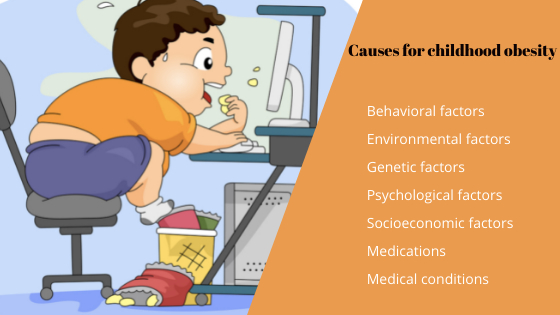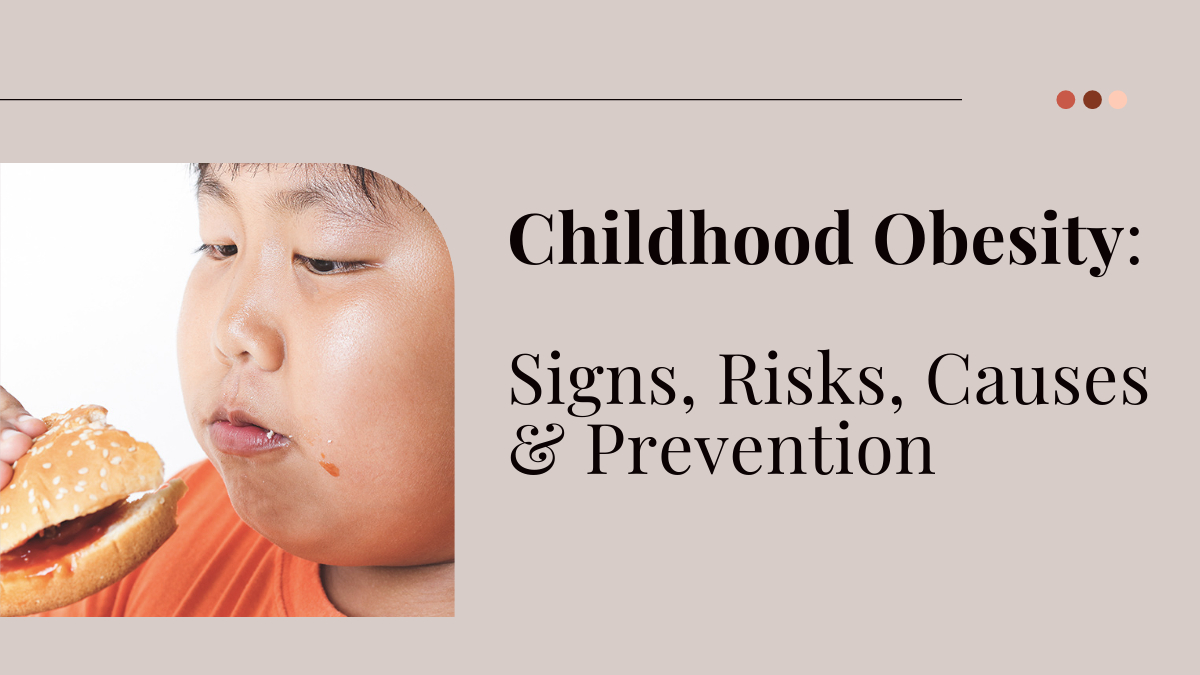Childhood obesity is one of the most serious health conditions that affect the 21st century. It was found that the number of overweight children under age 5 topped 41 million and the number between ages 5 and 19 was 340 million. Childhood obesity can lead to many kinds of problems like depression, poor self-esteem, and a lot more. There are many ways to reduce childhood obesity and the most preferred thing is to enhance the eating and exercise habits of your entire family. It will help you to protect your child’s health. Here is some essential information that you need to know about childhood obesity, its causes, and prevention factors.
Obesity is nothing but comparing the body mass index of the child to that of other children of their age and sex. The case is different for adults which relies solely on the person’s BMI measurement. Body mass index is all about the measure of weight about height, and is calculated by dividing a person’s weight in kilograms by the square of height in meters. You can also find many faces to calculate BMI online. A child with obesity problems will be at high risk for many diseases like sleep apnea, bone, asthma, joint problems, type 2 diabetes, and many other diseases.
BMI for age growth chart – Childhood Obesity
Here is a detailed BMI chart that you need to know about
A child with <5% is considered underweight.
A child with 5% to <85% is considered as normal weight.
A child with 85% to <95% is considered overweight.
A child with 95% or over is considered obese.
Causes for childhood obesity

There are many reasons for childhood obesity and the most common thing is a child is more likely to develop obesity when they eat more calories than their bodies use. This is called an energy imbalance which is caused by a variety of factors such as genetics, hormones, medical factors, and metabolic makeup. The main reason for childhood obesity is often through a complex interaction of these and other factors such as diet, lifestyle, and environmental conditions.
Some genetic characteristics might also cause a greater tendency to become obese. But if your child eats healthy foods and gets plenty of exercises, the gene won’t express itself and then he or she can maintain a weight in the normal range. Here are some other factors that cause obesity in children that you need to know about.
- Behavioral factors
- Environmental factors
- Genetic factors
- Psychological factors
- Socioeconomic factors
- Medications
- Medical conditions
Behavioral factors
Childhood obesity might also cause due to some behavioral factors such as eating high-calorie, low-nutrient foods and beverages like fast-food, snack foods, candy, and soda. Children get to become obese with they eat too much food and spend too much time sitting down watching TV or using a computer, tablet, or phone. Lack of physical exercise is one of the main behavioral factors for childhood obesity because children between the age of 6 and 17 years get at least an hour of moderate to vigorous exercise every day. And the child aged 5 and younger must be physically active throughout the day.
Environmental factors
There are some environmental factors that contribute to obesity. Some environmental factors include lack of easy access to healthy food, the opportunity for physical activity, lack of access to safe parks and other areas for physical activity, and other more. Some children might become obese due to being served high-calorie and low-nutrient meals regularly. This generation of kids is most likely to exposure to targeted marketing that promotes junk and fast foods.
Genetic factors
A genetic factor is one of the most common factors that most of you might know about. The child will undergo obesity if one of their parents is obese. But if a family experience obesity there are many ways for parents to help their child lower their risk. Some genetic syndrome can cause obesity in children either by causing constant hunger or by affecting the way fat is deposited in the body. Some genetic syndromes are Prader Willi syndrome, pro-opiomelanocortin deficiency, and leptin receptor deficiency.
Psychological factors
Some psychological factors that increase the chance of childhood obesity are stress, anxiety, and depression. Some might have learned to overeat in order to soothe or avoid difficult emotions such as loneliness, sadness, stress, and boredom.
Socioeconomic factors
Some Studies found that people in lower-income communities often lack access to buy fresh fruit and vegetables. And instead of that, they inhabit food deserts where they can buy only fast food, packaged food, and highly processed prepared foods. Financial struggle can also impact food purchasing as fast food and high-calorie food since they are often cheaper than healthier.
Medications
Also, some classes of medication can cause weight gain and contribute to obesity. Some medications that contribute to obesity include steroids, antidepressants, diabetes medications such as insulin, thiazolidinediones, sulfonylureas, and other anti-seizure medications.
Medical conditions
Some medical conditions also might be the reason for obesity, particularly one affecting the endocrine system. Hypothyroidism is an example of a medical condition where the thyroid gland secretes many thyroid hormones and leads to slow metabolism and weight gain. Additionally, there are many similar medical conditions that lead to weight gain and several health problems.
Signs and symptoms of childhood obesity
Here are some signs and symptoms of childhood obesity that you need to know about.
- Increased sweating
- Fatigue
- Shortness of breath
- Joint pain
- Dislocated hips
- Sleep apnea and snoring
- Skin rashes and irritation
- Stretch marks on hips and abdomen
- Fat tissues in the breast area
- Constipation
- Early puberty in girls and delayed puberty in boys
Childhood obesity prevention and treatment
Treatment of childhood obesity often includes changes in diet and activity level and learning and practicing new coping mechanisms for boredom, disappointment, and sadness. Sometimes treatments for obesity might also include medications or weight loss surgery. Before starting on anything it is best to a work with your pediatrician about your child’s diagnosis and treatment options. Here are some main treatment options for lifestyle changes that you can prefer.
Ensure your child gets adequate exercise
Having adequate exercise not only burns calories but also strengthens children’s bones and muscles. It helps them to fall asleep and get good quality rest and can boost their mood and energy. Children are expected to get between 150 and 300 minutes per week of moderately intense physical activity.
Intake of healthy foods
It is very important to serve your child healthy foods like fruits, vegetables, whole grains, seeds, nuts, and lean proteins. Including fresh fruits and vegetables in regular food habits is very essential. Ensure to cut back on foods like cookies, crackers, fast food, and prepared meals. All these foods can be high in sugar, fat, and calories. Ensure to include a healthy snack and meal choices. Most importantly try to accompany them with healthy dips and get your child involved in cooking healthy meals and making them feel like they are part of it in their spare time.
Limit sweetened beverages
Try to limit some sweetened beverages such as fruit juice and sodas. This is because these can be high in calories and low in nutrients. They also fill your child’s stomach and make it hard for them to eat the food that will keep them healthy and satisfied between meals.
Encourage eating together along with family
Practice your child to have food along with the family members and try to avoid the TV, computer, or video games at mealtimes. Sitting alone can encourage overeating and distract kids from their satiety signals. By eating along with family, your child will have mindful eating where they can focus on and enjoy their food. Ensure not to give one kid a special meal and everyone else has pizza this is because when they see you on the couch eating ice cream, they will want to do the same. So in the process of weight reduction ensure to have the same food that you are giving to your kids.
Limit take-out and eating out
Ensure to avoid taking your kids to restaurants often since outside meals are often high in sodium and fat. Foods high in sodium and fat can contribute to obesity and high blood pressure. Outside foods will be most often served in quantities that are huge than a child’s requirement.
Avoid making your child clean their plate
Ensure to allow your child to eat until full and not force them to clean their plate. This is because making them chela their plate will teach them to override fullness cues. While serving food remember one thing children don’t need as much food as adults consume. Kids always require a small portion of food and if they say they are full allow them to stop eating. But at the same time ensure that they intake enough food that their stomach requires.
Ensure they get enough good quality sleep
Lack of sleep will also lead to weight gain. Not getting enough sleep will increase the level of ghrelin, the hormone which is responsible for appetite. Less sleep might also rob your child of the energy to exercise during the day and encourage a craving for sugary foods for quick energy.
Summing it up – Childhood Obesity
There are many faces to come out of childhood obesity so don’t force your child on various things that stress them in the process of reducing weight. Also, before you start the process ensure to have a discussion on the same with your child’s pediatrician to avoid severe risk factors.



